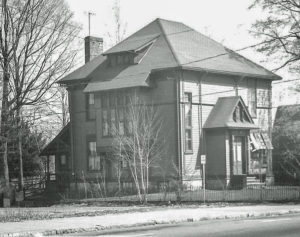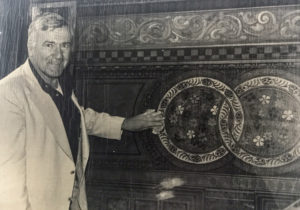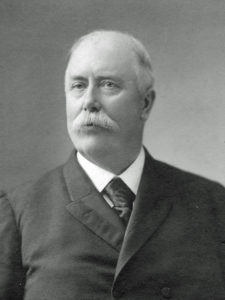True Tales from Canton’s Past: Our Painted Lady
By George T. ComeauCan a house have a gender? Are there feminine lines to some houses and in others masculine elements that give the observer the sense that a house has the grace of a lady or the demeanor of a gentleman? There is a term for beautiful old Victorian Style homes that describes them perfectly: painted ladies. The term was first used for San Francisco Victorian houses by writers Elizabeth Pomada and Michael Larsen in their 1978 book Painted Ladies: San Francisco’s Resplendent Victorians.

The Grover House in early 1978 before being moved to her present location (Courtesy of the Canton Historical Society)
So, where are our Painted Ladies? There are a handful of examples around town. Chapman Street has a small but distinct group, and there are some at Canton Corner. Yet perhaps the most elegant and highly detailed painted lady is the Grover House, now located next to the Canton Public Library.
Judge Thomas Ellwood Grover was an impressive man who befit the house that now bears his name. Grover descended from the earliest settlers in New England. On his paternal side, he descended from his namesake, Thomas Grover, who came to what is now Malden in 1635. His family went on to settle Mansfield in 1698. Grover’s father was a Quaker minister and his mother was from Attleboro and descended from the Perry and Lincoln families. Grover attended public schools and attended the English and Classical Academy of Foxborough. In that day, men aspiring to practice law would apprentice with lawyers. Grover came under the wing of Ellis Ames of Canton. In 1869, Grover was admitted to the bar and began his own practice here in town with a second office in Boston. By 1870, he was a trial justice in Norfolk County and he would remain a judge for over 20 years.
Grover was exceedingly good at his profession. In 1871, he was admitted to the United States Circuit Court and he would hold several other prominent positions throughout his life. At points in his career, Grover served as district attorney, a School Committee member of the Canton Public Schools, water commissioner, and from 1894 to 1895 a state representative to Canton and Milton. Known universally as fair and balanced, Grover was a solid Republican and town moderator known for wisdom in all his dealings.
In 1873, Grover married Frances Lydia Williams from Foxborough and within five years they would be in Canton. By the time Grover was 30 years old, he had done exceedingly well financially — well enough to hire an architect to build him a grand house in Canton. The site that was chosen was near where the Post Office is today. In fact, when you look at the lot where the Canton Co-operative Bank is, you can see the original granite bounds for the iron fence that once surrounded the property. At the corner of Ames Avenue and Washington Street, Grover set to build a work of art.
The project to build the house began in mid 1878 and by November the Grovers had purchased the property. The architect was F. Copeland, and he specified some of the finest materials and furnishings for this grand painted lady. The plans were carefully drawn and the bids for the construction were received in October.
Prices to build the house ranged from a low of $3,140 to a high of $5,300. As in all things, the low bid won the day, and the firm of E. Shapleigh of Traverse Street in Boston built the house. The work was begun on January 6, 1879, with a $300 deposit to start the job. The cellar was excavated by the Canton firm of Crimmins & Lawrence, but most of the building and craftsmanship came from outside of town.
Brilliant gas lamps lit the entire interior and more than 15 gas lighting fixtures were installed throughout the nearly 12 rooms. Steam-wrought iron radiators were also installed.
Completed in September, the Grovers prepared to move into their new home. The house had a grand parlor and a library on both floors. A grand wooden staircase led to the second floor, which had three bedchambers and a bathroom. A modern heating system added an element of luxury that the Grovers had come to expect.
The woodwork was spectacular throughout. Wainscoting, inlaid stairs, custom book and music cases, side boards and tables — all handcrafted. Twenty-six rosettes were hand carved and more than 700 feet of crown moldings completed the finishes. Stained glass was commissioned and luxurious wallpaper bought to adorn the interior. A grand lady to be sure.
Judge Grover died in 1910 and the house passed to his son Gregory, who lived there until he died in 1978. The house had fallen into some disrepair and was slated to be demolished to make way for a new bank. Yet there was a person who saw the majesty of the craftsmanship and decided to save the building. William “Billy” Reynolds stepped forward to purchase the building and move it to a vacant parcel he owned just up the street.
And so, on a warm summer day in 1978, electricity in Canton Center was shut off, and a large flatbed literally drove the Grover House to her new location. By all accounts, the entire town came to watch the spectacle. She was a huge house, and to simply drive her up the street seems comical today, but Billy Reynolds was a dedicated preservationist and accomplished businessman. It was Reynolds who spearheaded the original drive to save the David Tilden House at Pequitside, and he quietly donated a sizable amount of money several years ago to keep the work going such that we have success today.

William Reynolds inside the restored Grover House that he saved and moved onto his property (Courtesy of the Canton Historical Society)
The house slipped beautifully onto her new foundation and is well preserved today. The carriage house behind the current location is also original to the Ames Street property. All in all, the Grover House is a spectacular lady that has aged with grace and dignity. Many of the details are still evident both inside and out.
One sad footnote: For years it was rumored that the stained glass that once adorned the windows of the Grover had been crated and stored on the second floor of the Canton Co-operative Bank. This author made several attempts to track them down. Thought lost forever, they have since been found.
On June 7, 2017, a pair of windows were auctioned at Christie’s in New York City with auction item listed as Lot 32. The windows presented were an excellent example of windows of this period and the auction expert identified them easily. This lot was the long-rumored Canton window done by noted artists John La Farge entitled “Hollyhocks and Morning Glories.”
They are jaw-droppingly beautiful: “La Farge’s confetti glass is liberally used in the borders of both windows, as are cast-glass jewels. The outer border of Moon over Clouds is embellished with stylized chrysanthemums formed of faceted oval jewels set in a band of confetti glass. The rectangular panels above and below this border mimic the bands found in kakemono. In Hollyhocks and Morning Glories, round and ovoid cabochons form floral devices in the four corners of the panel. Square cabochons punctuate the confetti-glass border. Floral arabesques with deep red backgrounds above and below the floral scene emulate Japanese damasks.”
The windows sold for $37,500 — never to be seen again in Canton.
Fortunately, we can see still this painted lady in Canton Center. The building today houses commercial tenants and has been recommended as eligible for the National Register of Historic Places by the Canton Historical Commission. Yes, she is indeed wonderful.
Short URL: https://www.thecantoncitizen.com/?p=50257











